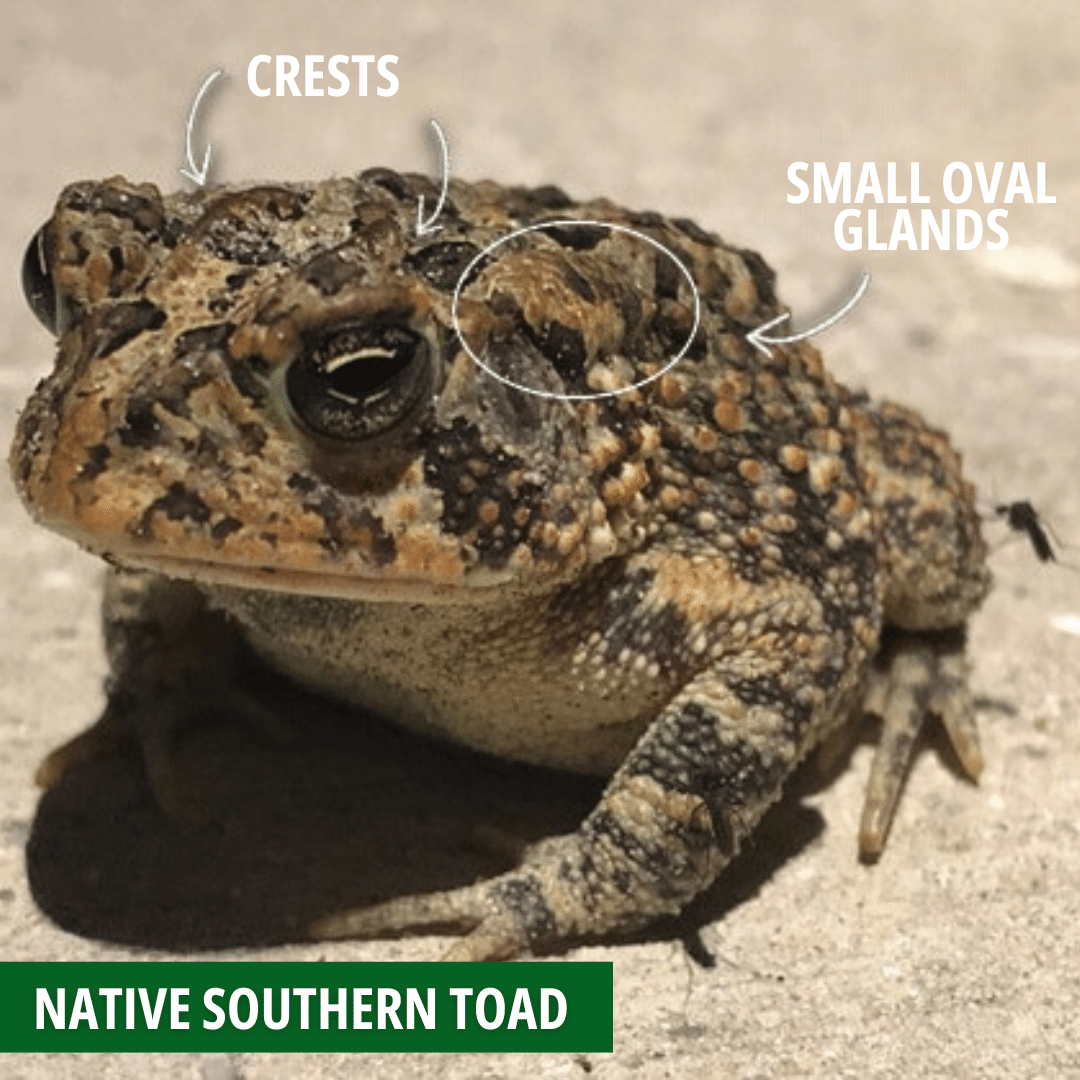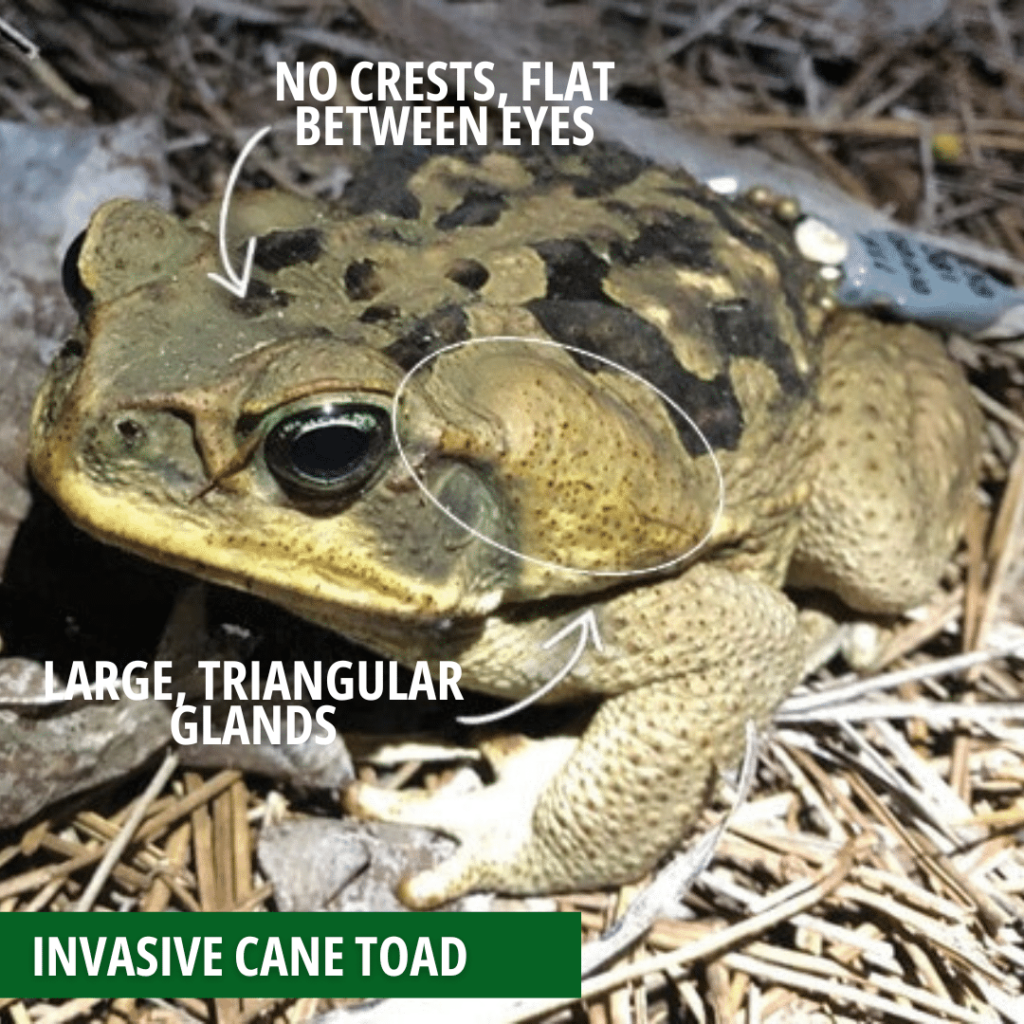
NATIVE SOUTHERN TOAD

As the rainy season gets underway in Southwest Florida, you may see an influx of cane toads in your backyard and surrounding areas. Cane toads are one of the largest species of toad in the world posing a danger to pets due to their toxic nature. Native to South America, the species was originally introduced to Florida in the 1930s-1940s in an attempt to control agricultural pests in sugar cane fields, and the pet trade contributed with releases and escapees during the 50s-60s.
While not aggressive, they possess enlarged parotoid glands on their neck and shoulder region that produce a bufotoxin, a powerful toxin that can be fatal to pets if ingested. This toxin is capable of causing severe illness or death to potential predators and poses a threat to our native wildlife and to any pets that attempt to attack them.

It is important to note that there are other toad species that are native to Southwest Florida. The native southern toad is the species most likely to be misidentified as the cane toad. The large size is often the first noticeable feature of cane toads. However, cane toads are not always bigger than southern toads, so it is important to be familiar with features that help distinguish the species when they are both a similar size.
The best features to look for are the southern toad head crests! When southern toads are around an inch and a half in length they start to display small ridges of crests on their heads, between the eyes, while the area between cane toad’s eyes will always remain flat. It is almost impossible to distinguish the two species when they are at any other life state (eggs, tadpoles) or smaller toad in size.
Cane toads prefer habitats created and inhabited by humans. They are particularly common in yards, golf courses, and school campuses. (However, they do not appear to invade most natural areas in the state.) They eat almost anything of appropriate size and are often drawn to pet food left outside. Make your yard less appealing by using yellow bug lights, not leaving pet food or water outside after dark, and removing brush piles.
Unfortunately, dogs and cats that attack or try to eat this highly toxic toad can be poisoned. Dogs are considerably more likely than cats to attempt to eat them, especially dogs like terriers that readily attack small animals. Severity of symptoms varies depending on the amount of toxin ingested and the size of the animal that attacked the toad, but signs of cane toad poisoning in pets include unusually pink or red gums, drooling or frothing at the mouth, pawing at the mouth, seizures, and sometimes cardiac arrest. Reports of pets, particularly dogs, falling sick or dying after attempting to eat cane toads are not uncommon in southern Florida. If you suspect your pet has eaten or attacked a cane toad, wipe its mouth out with a damp rag and use a hose to rinse its mouth for 15 minutes, making sure the water flows out of the mouth and not down the throat. And immediately contact your veterinarian!
Additionally, the secretion from cane toad parotoid glands is highly irritating to human eyes and cuts on skin. Therefore, cane toads should be handled with gloves and extreme care should be taken to avoid getting toxin in eyes—wash hands thoroughly after handling a cane toad.
To get rid of cane toads in Florida, humanely kill them on your property, or consider hiring a wildlife trapper. Cane toads are not protected in Florida except by anti-cruelty laws, and they can be removed and killed year-round on private property with landowner permission.
Here’s how to safely remove and euthanize cane toads:
1. Identify the toad: Make sure you’re dealing with a cane toad and not a native Southern toad, which is beneficial to the ecosystem.
2. Safety first: Wear eye and skin protection, and gloves (latex, rubber, or nitrile) when handling.
3. Humanely euthanize: The University of Florida recommends rubbing or spraying 20% benzocaine toothache gel or sunburn spray on the toad’s back or lower belly. After a few minutes, it will be unconscious.
4. Freeze for 24-48 hours: Place the unconscious toad in a sealed plastic bag and store it in the freezer for 24-48 hours to ensure it is fully euthanized.
5. Dispose of the toad: Do not bury the toad; place it in the trash.
Important note: Captured cane toads cannot be relocated and released, according to the Florida Fish and Wildlife Conservation Commission.
Notes:
Conservancy of Southwest Florida
Florida Fish and Wildlife conservation Commissionaskifas (University of Florida)






